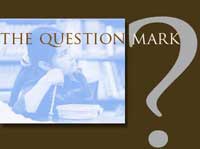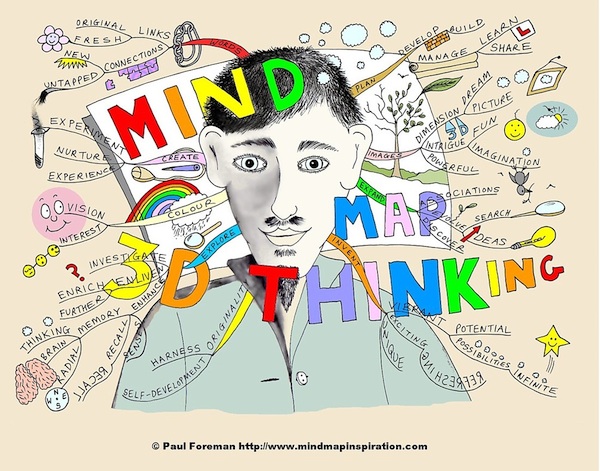| Research Cycle |
Order McKenzie books online with a credit card
|
|
|
| Vol10|No2|December |2013 | |
Generating Question Families
by Jamie McKenzie (about author)
Connecting the Dots In 2009 I outlined this approach in "Connecting the Dots," an article that first appeared in Knowledge Quest, a publication of the American Association of School Librarians. A class exploring the question of what they should do about floods starts with a simple diagram like the one below.
But it soon becomes much more complex. Questions are grouped and organized to emphasize causes and effects as well as past efforts and planning issues. This is unlikely to happen unless the teacher helps the group to recognize that questions work best when arranged conceptually.
Going Beyond Brainstorming Simple listing generates seemingly unrelated questions. If these questions are then divided amongst team members for research, it is likely that they will go out and collect chunks of information that cast little light on the main question or issue. Illumination and understanding is best served by a focus upon relationships. If the questions focus only on information nuggets, the class ends up with heaps of information that amount to little more than a hill of beans. And these will not even be magical beans! Mere scooping amounts to faux inquiry.
All too often students are asked to learn about important people from the past in ways that encourage scooping. When was Matthew born? What did he discover? When did he die? Determining his character is a much more challenging task, especially if the student must provide evidence to substantiate judgments instead of simply quoting the "experts."
This image is used with permission from Paul Foreman. He is the producer of many great mind maps. Dynamic Mind Mapping This approach to planning research thrives on group mind-mapping with appropriate software projecting onto a screen or white board that can be viewed by the whole class. Rearranging and grouping the questions is an essential aspect of transforming the research from mere scooping and gathering to something far more dynamic.
Few teachers have enjoyed a 2-3 day workshop showing them how to conduct such a planning session. Few have experienced mind-mapping workshops or training, though they may have had sessions with the software. This is not so much about software. It is about organizing ideas and questions so they muddle together in fruitful ways. Conventional approaches to school research have generally been more static than dynamic. In one series of workshops I challenged teachers to determine which of the following figures showed the most courage: Joan of Arc, Captain James Cook or Nelson Mandela? The Importance of Defining Terms Early Before the group could begin organizing their investigation, we devoted a day to the key concept - which was the word courage. How can anyone compare these three leaders' courage without first developing a rich understanding of the concept? To get a sense of how this exploration proceeded, take a look at the article, "Studying Complex Concepts such as Beauty, Truth and Courage in Depth." Whenever a class is exploring a question of import, it is essential that the teacher engage the students in a thorough review of the key concepts. It is a step that should but rarely does precede brainstorming. Rather than seeking tight definitions, it works best to gather a cloud of related words. The thesaurus is a better source for this phase than a dictionary. The thesaurus on my laptop suggests the following words for courage:
The same thesaurus suggests different words for brave:
Some of the difference is explained by parts of speech. But it turns out that courage is multi-faceted and rather complicated. Battlefield courage certainly differs from hospital or athletic courage. Thesaurus.com enriches our list . . .
In the mind map below, there is room for related words like the ones listed above, but students are also encouraged to explore how courage is treated in quotations using a Web site such as Thinkexist.com. Winston Churchill once wrote that “Courage is what it takes to stand up and speak; courage is also what it takes to sit down and listen.” Students are enriching, expanding, deepening and broadening their understandings.
August Wilson wrote, “Confront the dark parts of yourself, and work to banish them with illumination and forgiveness. Your willingness to wrestle with your demons will cause your angels to sing. Use the pain as fuel, as a reminder of your strength.” Alex Karras wrote, “It takes more courage to reveal insecurities than to hide them, more strength to relate to people than to dominate them, more 'manhood' to abide by thought-out principles rather than blind reflex. Toughness is in the soul and spirit, not in muscles and an immature mind.” Most adults and students have scant knowledge of the concept. Pressed to write definitions early in the investigation, they will tend to write superficial and simplistic definitions. The Teacher Orchestrates A fruitful investigation is most likely to occur when the teacher helps the class to see the conceptual structures underlying the question or issue at hand. In determining the character of a person from history, for example, the teacher will show the class the importance of key words related to character. They will also show the class how character is shown through action, emphasizing the importance of stories from the character's life. Different types of research questions will demand different conceptual structures. Each time students encounter a new kind of research challenge, they will need guidance from a teacher to define the types of questions required.
|
Copyright Policy: Materials published in The Question Mark may be duplicated in hard copy format if unchanged in format and content for educational, nonprofit school district and university use only and may also be sent from person to person by email. This copyright statement must be included. All other uses, transmissions and duplications are prohibited unless permission is granted expressly. Showing these pages remotely through frames is not permitted. FNO Press is applying for formal copyright registration for articles. |





 To make meaning, students must learn to structure inquiry around conceptual relationships. When wrestling with a difficult jigsaw puzzle, most of us organize the pieces into small piles, looking for corners, straight edges, common colors and images like houses or faces. Planning an investigation requires intense synthesis - combining, recombining and regrouping questions so that patterns of meaning emerge. Real research involves more than finding answers. It requires the building of answers around puzzling issues and questions.
To make meaning, students must learn to structure inquiry around conceptual relationships. When wrestling with a difficult jigsaw puzzle, most of us organize the pieces into small piles, looking for corners, straight edges, common colors and images like houses or faces. Planning an investigation requires intense synthesis - combining, recombining and regrouping questions so that patterns of meaning emerge. Real research involves more than finding answers. It requires the building of answers around puzzling issues and questions.





